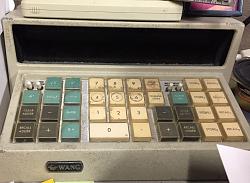Model engine builders are always casting about for ideas for devices to be powered by their steam engines. This project is the ultimate, both intriguing and historically significant...


dbeierl (Apr 8, 2018), gunsgt1863 (Apr 3, 2018), Jon (Apr 2, 2018), oldcaptainrusty (Apr 3, 2018), Paul Jones (Apr 2, 2018), PJs (Apr 4, 2018), Seedtick (Apr 2, 2018)
Marv,
That is very interesting, impressive and powered by a steam engine!
Thank you for sharing this video.
Paul
BTW - I have a Friden Mechanical Calculator that has been sitting in my dusty attic for more than 20 years. It used to work but that last time I turned it on was probably more than 30 years ago. The calculator requires a very good cleaning before I will attempt to run it again. Someday, I also wanted to replace the steel case cover with one made from acrylic or Lexan so we can see the all the gears turning.

Last edited by Paul Jones; Apr 2, 2018 at 09:39 PM.
PJs (Apr 4, 2018)
In my early days in the aerospace ratrace, we had assistants, mostly female, called "computeresses". We would turn long, boring calculations over to them while we worked on more interesting things. One of the computeresses was armed with a Friden which had the capability to do square roots. When roots were required, the other gals would turn the calculation over to her.
I'm not sure how the root was calculated (perhaps Newton's method) but the machine would clatter away for what seemed an endless time to produce an answer. If one's office was within earshot of the machine it was nearly impossible to concentrate.
When electronic calculators finally appeared on the scene, many of us appreciated the silence more than we did the speed with which an answer appeared.
---
Regards, Marv
Failure is just success in progress
That looks about right - Mediocrates
DIYer (Apr 3, 2018)
Great story Marv. I am starting to look at some of the YouTube videos on Friden calculator repairs. These are interesting mechanical devices but I never used one. In the late 70's I was in an R&D lab where the 1950s vintage old Fridens were removed from storage as surplus equipment and to be thrown into the dumpsters. They let me take one home and that is why I still have it. The oldest calculator I remember using in the late 60's was a Wang electronic calculator with those cool looking nixie tube displays.
I used to program in FORTRAN approximations based Newton's Method in grad school and after going to work in oil and later in gas exploration developing software. My PhD is in Geophysics but minored in Mathematics with a specialty in numerical methods. The nice thing about Newton's Methods is it converges pretty quickly using a computer but it would drive me nuts to have to do this manually. In fact with the use of computers some of the old numerical methods were discovered to be unstable if calculating high precision with hundred to thousands of iterations but the instabilities were never discovered when done by hand. Once you were aware of the situations you could mathematically prove the existence of an unsuitability. This very important to know in automated controls.
Last edited by Paul Jones; Apr 2, 2018 at 09:47 PM.
Yes, iterative equations can be the bane of computer modeling. I ran into problems with one on a simulation I was building...
One of the simplest iterative equations that is used in predicting the size of populations...
X{n+1} = R * X{n} * (1 - X{n})
is stable for small values of R, but begins a series of bifurcations at R = 3 and then goes fully chaotic for R>=3.57.
It really confused me until I did some research on chaos theory and got a handle on it. It seemed impossible to me that such a simple equation could become chaotic that I modeled it explicitly apart from my simulation and used it to draw some nice computer screen representations of the onset of chaos.
Thanks for the memories, Paul.
---
Regards, Marv
Failure is just success in progress
That looks about right - Mediocrates
Paul Jones (Apr 2, 2018)
Paul Jones (Apr 2, 2018)
Paul Jones (Apr 2, 2018)
Weird coincidence...I actually have one of those Wang display bit on my desk right now...a prof back in the 80's used one for pharmacokinetics calculations. Somewhere along the years the calculator part disappeared, and all that was left was the display. I"ve sometimes considered cleaning it up, and figuring out how to attach something like a Raspberry PI to turn it back into a functioning calculator...

Paul Jones (Apr 2, 2018)
I hope you can have the Wang display running again. Old technology but with a lot of history.
In the late 60's as an under grad, I used the Wang electronic calculators with the beautiful orange nixie tube displays. The old Wang calculators used a central CPU with at least four nixie tube keyboards and display tubes units connected to the central CPU. One of the keyboards/nixie tube displays would occasionally lock-up requiring a total reset to the Wang central CPU unit. We asked everyone their permission before doing a cold re-boot to rest the Wang CPU. Today we don't think twice about doing the re-boot.

New plans added on 01/17/2025: Click here for 2,706 plans for homemade tools.
There are currently 1 users browsing this thread. (0 members and 1 guests)
Bookmarks